Understanding Treatment Options for Knee Osteoarthritis
Knee osteoarthritis affects millions worldwide, causing pain, stiffness, and reduced mobility. Traditionally, treatments ranged from conservative management to invasive surgeries like knee replacement. However, recent advancements have introduced less invasive procedures such as genicular artery embolization (GAE), providing new hope for patients seeking effective pain relief with minimal downtime. This article explores the benefits of GAE compared to conventional knee surgery, examining effectiveness, safety, recovery, and patient suitability.
Overview of Traditional Knee Surgery and Its Challenges
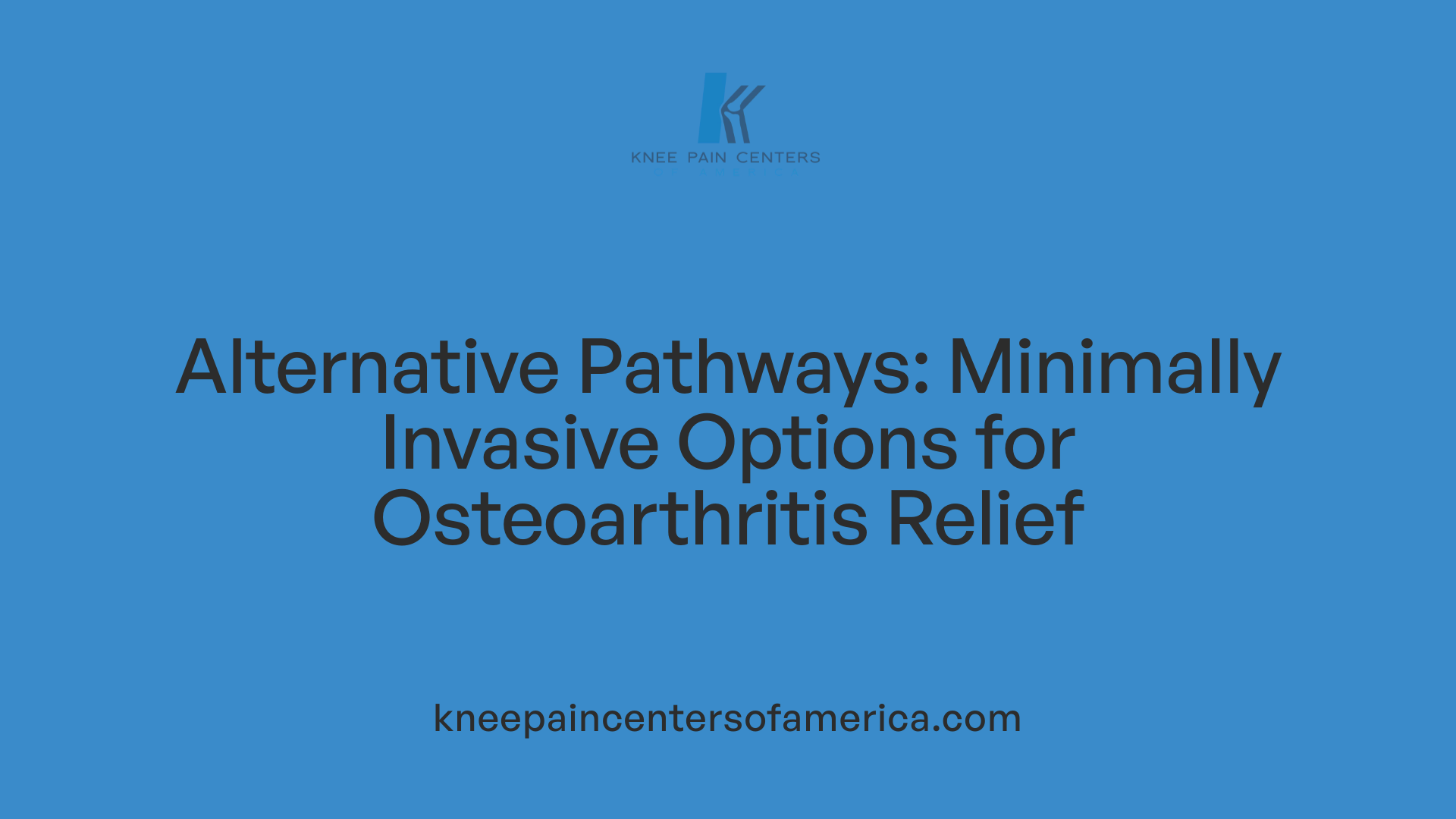
What are the main procedures involved in knee replacement surgery?
Knee replacement, also known as knee arthroplasty, is a surgical procedure aimed at restoring function to a damaged knee joint. It involves the removal of deteriorated bone and cartilage from the femur (thighbone), tibia (shinbone), and sometimes the kneecap. These surfaces are then replaced with artificial components made of metal, plastic, or a combination of both, designed to mimic natural knee movement.
The entire process typically lasts between 1 and 2 hours. During the operation, surgeons carefully remove the damaged joint surfaces and secure the artificial joint using cement or press-fit techniques. The procedure helps alleviate pain and improve joint stability in patients with severe osteoarthritis or joint damage.
How long does recovery generally take after knee replacement?
Post-surgery recovery involves multiple stages. Patients usually stay in the hospital for 1 to 3 days for initial wound care and monitoring. Once discharged, they enter a rehabilitation phase that encompasses extensive physical therapy sessions focused on restoring movement, strengthening muscles, and improving joint function.
Full recovery from knee replacement can take from 6 months up to a year. During this period, patients are advised to avoid high-impact activities and follow a structured outpatient rehab program. While many regain significant function within a few weeks, persistent stiffness or pain may require additional treatment or adjustments.
What are the risks associated with knee replacement?
Although knee replacement is generally successful, it carries certain risks due to its invasive nature. Possible complications include:
- Infection at the surgical site
- Blood clots forming in the legs or lungs
- Nerve or blood vessel injury during surgery
- Prosthetic loosening or wear over time
- Persistent pain or stiffness
These complications, while rare, can significantly impact recovery and may necessitate further interventions or revision surgeries. Therefore, thorough preoperative assessment and postoperative care are essential parts of the treatment plan.
| Aspect |
Description |
Additional Details |
| Procedure Duration |
1-2 hours |
Time taken for surgery |
| Hospital Stay |
1-3 days |
Postoperative recovery period |
| Recovery Timeline |
6 months to 1 year |
Total functional recovery |
| Risks |
Infection, blood clots, nerve damage |
Rare but serious complications |
| Physical Therapy |
3-4 weeks |
Essential for restoring movement |
What are alternative minimally invasive options to knee replacement surgery for osteoarthritis?
For patients seeking less invasive solutions to manage osteoarthritis pain, several alternatives exist that may delay or even circumvent the need for joint replacement. These options range from conservative therapies to minimally invasive procedures.
Conservative treatments include physical therapy, which strengthens the muscles supporting the knee, increasing stability and range of motion. Medications like NSAIDs (non-steroidal anti-inflammatory drugs) help reduce pain and inflammation without the need for surgery.
Injectable therapies offer temporary relief. Corticosteroid injections diminish inflammation and pain for weeks to months, while hyaluronic acid injections aim to lubricate the joint and improve mobility.
Procedures such as arthroscopic surgery allow for minimally invasive repairs—removing loose cartilage, ligament repair, or debris removal—to delay progression and the need for total joint replacement.
Emerging treatments include outpatient peripheral nerve stimulation, stem cell injections, and new techniques like genicular artery embolization (GAE). GAE, specifically, involves blocking blood flow to inflamed areas of the knee, thereby reducing pain and inflammation. It’s performed with minimal invasion, has a quick recovery time, and can be repeated as needed.
These options offer viable alternatives, especially for patients with mild to moderate osteoarthritis, helping improve quality of life with fewer risks and shorter recovery periods.
Introduction to Genicular Artery Embolization: A Minimally Invasive Alternative
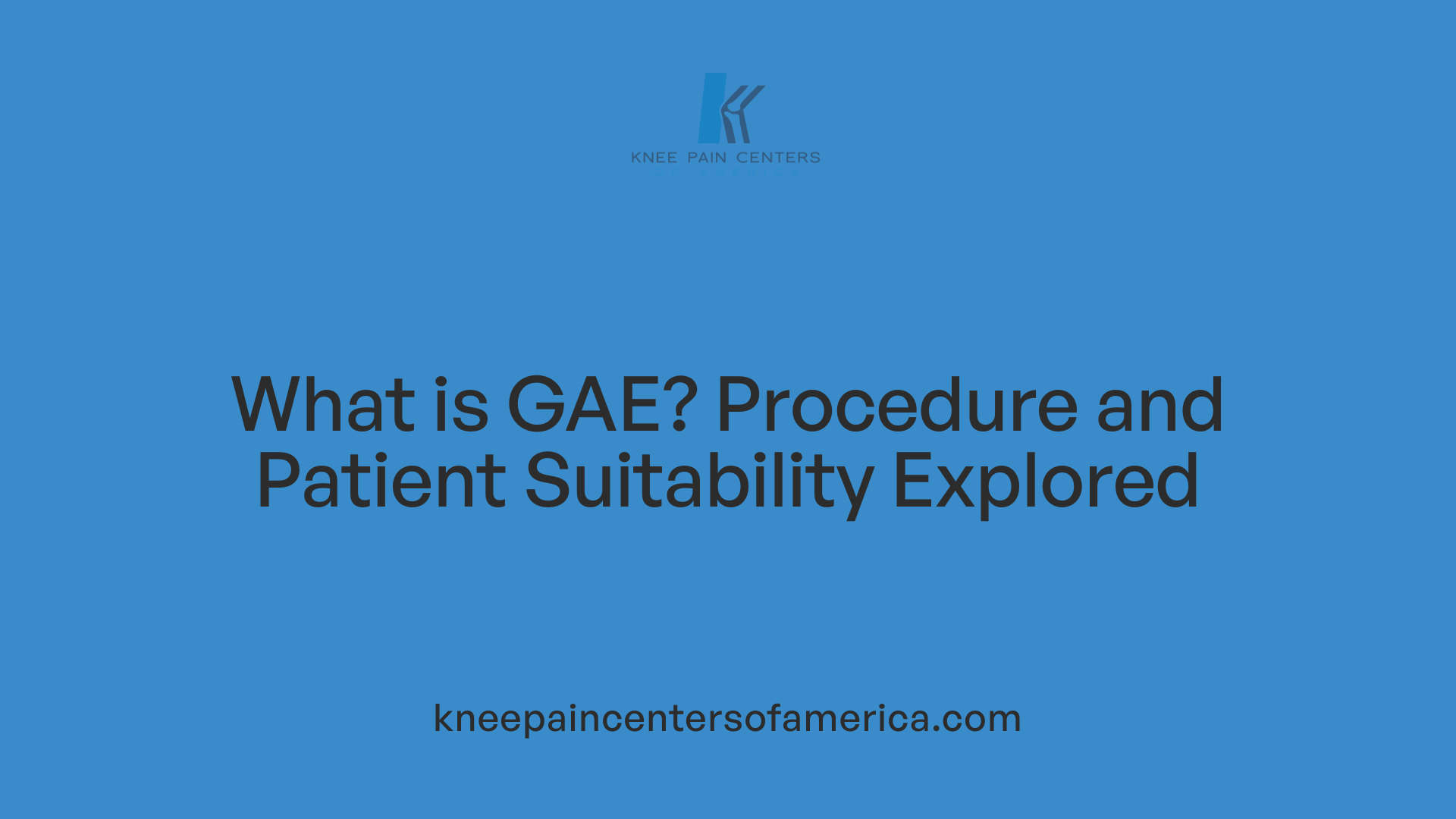
What is GAE and how is it performed?
Genicular artery embolization (GAE) is a cutting-edge, minimally invasive outpatient procedure designed to help reduce knee pain caused by osteoarthritis and other degenerative joint conditions. It involves inserting a tiny catheter into the arteries that supply blood to the knee, known as genicular arteries. This process is guided by real-time X-ray imaging, ensuring precision in targeting the problematic blood vessels.
Once the catheter is in place, trained specialists inject small embolic particles into these arteries. These particles successfully block abnormal blood flow, which plays a significant role in causing inflammation and discomfort within the joint. By reducing this inflammation, GAE alleviates symptoms, leading to decreased pain and improved knee functionality.
The entire procedure typically lasts between one and two hours. Because it’s performed on an outpatient basis, most patients are able to go home the same day. Recovery involves minimal downtime, with many individuals resuming light activities within a week.
Who is a suitable candidate for GAE?
A suitable candidate for GAE is generally an adult aged 40 years or older who suffers from moderate to severe localized knee pain due to osteoarthritis or similar degenerative conditions. These individuals often have not experienced sufficient relief through conservative treatments such as physical therapy, medications, or joint injections.
Candidates should have significant pain that limits their mobility and diminishes their quality of life, but they must also be in good general health to undergo catheter-based procedures. GAE is particularly appealing for those who are interested in avoiding or delaying traditional knee replacement surgery because it is less invasive and has a quicker recovery period.
It's essential for candidates to discuss their specific health situation with an interventional radiologist or orthopedic specialist to determine if GAE is appropriate. The procedure offers a promising alternative for patients seeking pain relief with fewer risks and a shorter recovery period.
Benefits of GAE over traditional surgery
Compared to knee replacement or other invasive procedures, GAE offers multiple advantages:
- No hospital stay and minimal disruption to daily life
- Outpatient procedure with no need for general anesthesia
- Shorter recovery time—most patients return to light activities within a week
- Lower risk of complications such as infections or blood clots
- The ability to repeat the procedure if necessary
- Potential to delay or even avoid the need for joint replacement altogether
Research shows that patients experience meaningful pain relief typically within two weeks, with many enjoying symptom improvement for one to three years. Patients also report improved knee function and increased range of motion.
Our focus on innovative treatments
At the forefront of this minimally invasive trend, clinics specializing in advanced knee pain management, like the American Knee Pain Centers, utilize GAE as part of their treatment protocols. Their team of interventional radiologists and orthopedic specialists focuses on personalized care, aiming to improve patient outcomes with safer, less invasive options.
GAE stands out as an effective, safe, and patient-friendly alternative to more invasive procedures. Most patients find it a preferable choice, especially those with moderate to severe osteoarthritis who want to preserve their natural joint and avoid a long recovery.
Clinical Evidence and Effectiveness of GAE
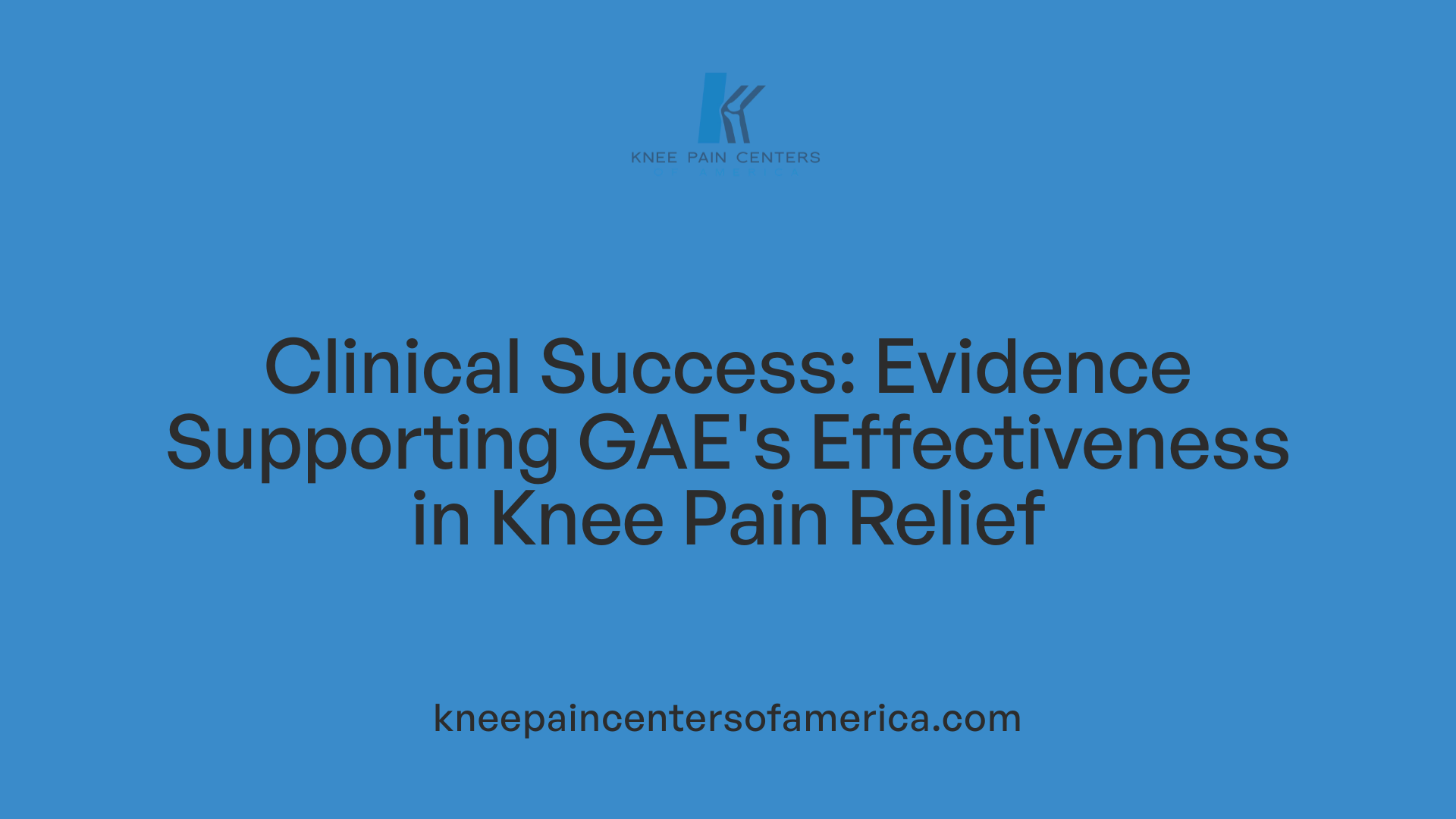
What is involved in the genicular artery embolization procedure, and what clinical evidence supports its use?
Genicular artery embolization (GAE) is a minimally invasive outpatient procedure designed to alleviate knee pain caused by osteoarthritis. During GAE, a small catheter is inserted through a tiny puncture in the leg and guided by real-time imaging such as fluoroscopy or angiography. Using this guidance, interventional radiologists inject embolic materials, such as microscopic beads or particles, into the genicular arteries surrounding the knee. These particles selectively block abnormal blood vessels that supply inflamed synovial tissue, reducing inflammation, swelling, and pain.
The procedure typically lasts between one to two hours and does not require general anesthesia, often performed under moderate sedation. Most patients go home the same day and can resume light activities within a week.
Clinical evidence compellingly supports the use of GAE. Multiple studies, including randomized controlled trials and meta-analyses, demonstrate significant pain reduction and functional improvement in patients following GAE. For example, a 2023 study reported a success rate of 99.7% in technical terms, with over 78% of patients experiencing meaningful symptom relief that met clinical improvement thresholds such as minimal clinically important difference (MCID) in pain and function scores.
Patients often notice benefits as early as two weeks after the procedure, with symptom relief lasting from six months up to three years. Most notably, the WOMAC (Western Ontario and McMaster Universities Osteoarthritis Index) scores, a standard measure of arthritis symptoms, show reductions of around 60% at 12 months, reflecting substantial improvements in pain, stiffness, and physical function.
Safety profiles for GAE are also favorable. The most common adverse effects are minor and transient, including skin discoloration (11.6%), mild knee pain, or swelling shortly after the procedure. Serious complications are rare, making GAE a safe treatment option.
Overall, the clinical data consistently support GAE as an effective, minimally invasive alternative for those with moderate to severe knee osteoarthritis, especially for patients who have not responded well to conservative treatments or wish to delay or avoid more invasive surgery.
Safety Profile and Risks of GAE versus Surgery
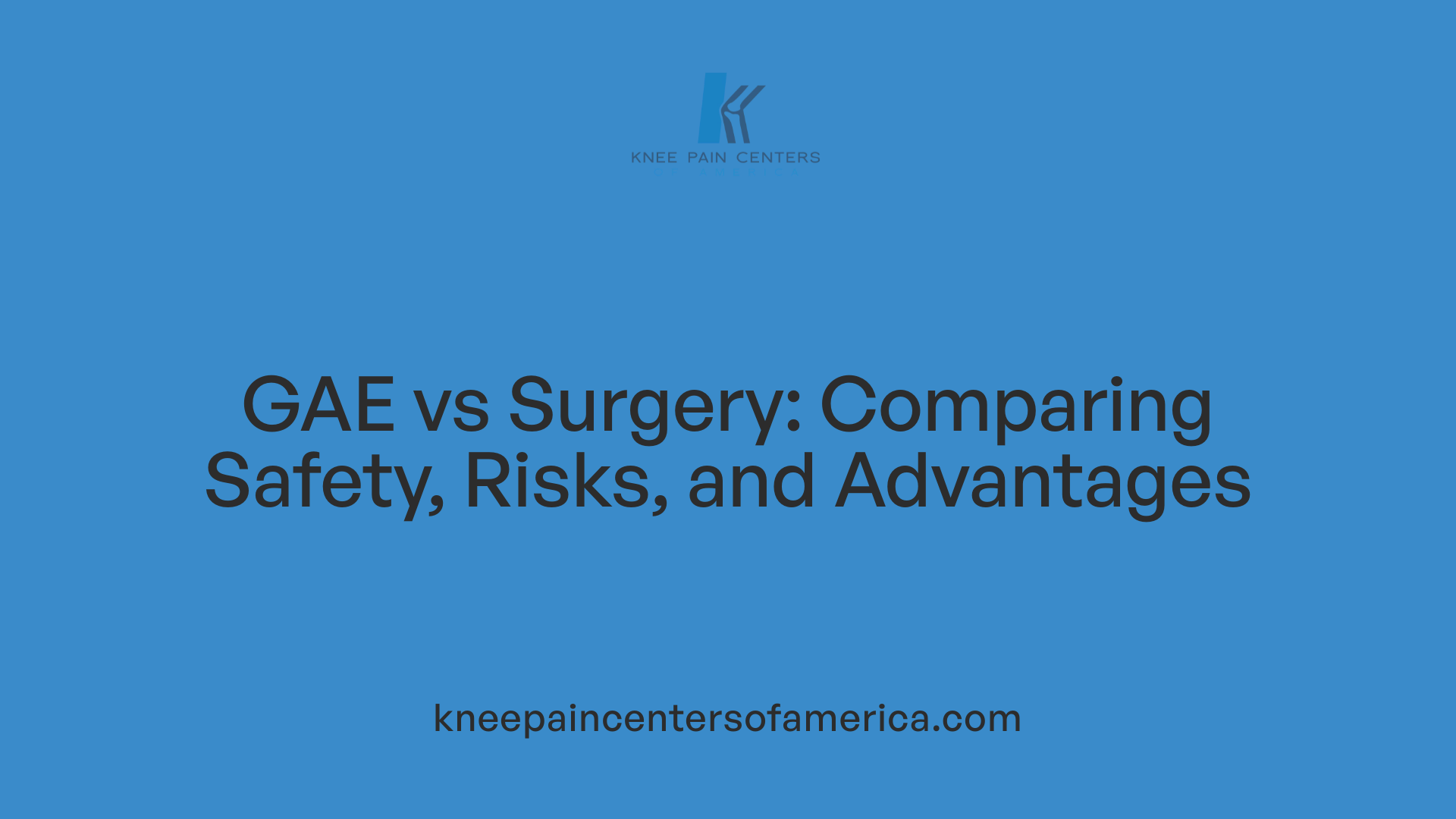
What are the risks and disadvantages associated with genicular artery embolization compared to knee surgery?
Genicular artery embolization (GAE) is recognized for its safety and minimally invasive nature. It involves inserting a tiny catheter guided by imaging techniques like X-ray, MRI, or CT scans to deliver microscopic particles into the arteries supplying the knee joint. Most patients experience minor, temporary side effects such as skin discoloration, mild pain, swelling, or brief numbness that resolve quickly. Serious adverse events, although rare, include infections, nerve injuries, blood vessel damage, allergic reactions, and small infarctions in the bone. These risks are considerably lower compared to traditional surgery.
Knee replacement and other surgical procedures are more invasive, involving large incisions, removal of joint tissues, and placement of artificial components. They pose higher risks such as postoperative infections, significant blood loss, nerve damage, blood clots, and longer recovery periods often extending several months. The need for extensive physical therapy and the potential for complications like prosthetic loosening or wear further increase the risk profile.
Comparing the safety and disadvantages
| Aspect |
GAE |
Knee Surgery |
Explanation |
| Invasiveness |
Minimally invasive, outpatient |
Surgical, involves incisions |
GAE requires no large incisions, less trauma |
| Anesthesia |
Often mild or moderate sedation |
General or regional anesthesia |
GAE can be performed with lighter sedation |
| Recovery Time |
Light activities within a week |
Several weeks to months |
GAE recovery is quicker, fewer restrictions |
| Risks |
Mild, transient side effects; rare serious events |
Infection, blood clots, nerve damage, longer recovery |
Surgery carries more serious, long-term risks |
| Long-term Outcomes |
Significant pain relief, 1-3 years benefit |
Fixes joint damage, longer-lasting |
GAE mainly relieves symptoms temporarily but delays surgery |
Broader considerations
Patients considering GAE often cite its safety and quick recovery as advantages, especially when conservative therapies fail or surgery is contraindicated. GAE's success rate is exceptionally high, with nearly 99.7% technical success, and most patients see improvements lasting 1 to 3 years.
In contrast, knee surgery, such as knee replacement, though more definitive for end-stage disease, entails longer hospital stays, extensive rehabilitation, and higher complication risks.
Summation
Overall, GAE offers a safer alternative for managing knee osteoarthritis, with fewer and less severe risks than surgery. While it may not replace surgery in cases of advanced joint damage, it is especially suitable for patients seeking symptom relief with minimal procedural risks.
This comparison underscores GAE’s role as an effective, low-risk option, capable of delaying or avoiding invasive surgery for many patients.
Advantages and Long-term Outcomes of GAE
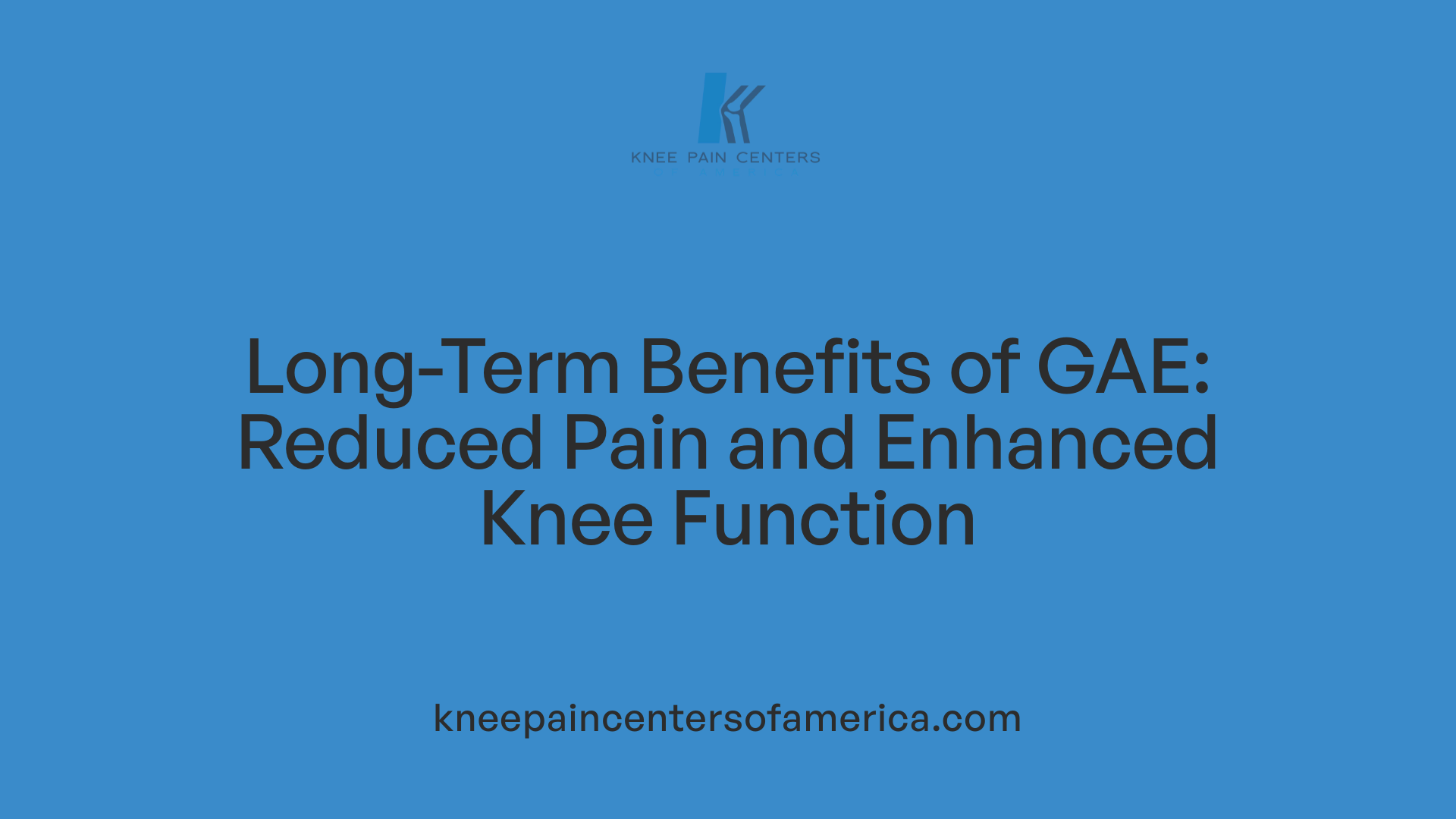
What are the benefits of genicular artery embolization for treating knee osteoarthritis?
Genicular artery embolization (GAE) provides a range of advantages for patients suffering from moderate to severe osteoarthritis of the knee. This minimally invasive outpatient procedure effectively reduces knee pain by decreasing inflammation and swelling in the joint. Because GAE does not involve large incisions or removal of joint structures, it avoids many complications associated with traditional surgery.
The procedure can be performed under moderate sedation and typically takes less than two hours. Patients often experience immediate benefits, with significant pain relief beginning approximately two weeks after the treatment. Most are able to go home the same day and resume light activities within a week. This rapid recovery process is a notable benefit compared to more invasive options like knee replacement, which require longer hospitalization and extensive rehabilitation.
Clinical studies have shown that GAE leads to significant improvements in pain and knee function. For example, around 78% of patients report meeting the minimal clinically important difference (MCID) for pain reduction, and more than 92% experience enhanced overall knee function within a year.
Another notable advantage is that GAE can be repeated as needed, which helps prolong relief and delay the need for invasive joint replacement procedures. Patients who undergo GAE multiple times can maintain improved mobility and reduction in pain over several years.
Most adverse effects from GAE are minor and temporary, such as skin discoloration or mild knee discomfort immediately after the procedure. The high safety profile, combined with its effectiveness, makes GAE especially appealing to older adults or those with comorbidities who are risk-averse or not suitable for major surgery.
In summary, GAE offers an effective, quick, and less invasive option for managing knee osteoarthritis symptoms, with benefits lasting from one to three years or more. Its ability to improve quality of life and knee function, coupled with its low complication rate, underscores its growing role in modern osteoarthritis treatment strategies.
Summary and Future Perspectives
How does genicular artery embolization compare to traditional knee surgery regarding effectiveness, safety, and outcomes?
Genicular artery embolization (GAE) is rapidly emerging as an important minimally invasive treatment option for knee osteoarthritis. It focuses on reducing inflammation and pain by blocking abnormal blood flow to affected areas, which can significantly improve symptoms. Multiple studies have demonstrated that GAE provides substantial relief, with many patients experiencing pain reduction lasting 6 months to over 2 years.
Compared to traditional knee surgeries like total knee replacement, GAE offers several advantages. It is performed as an outpatient procedure with no need for general anesthesia, meaning patients can go home the same day with minimal recovery time. Most are able to resume light activities within a week, and the procedure itself takes just about an hour. Serious complications are rare, and side effects, such as temporary skin discoloration or mild knee pain, tend to resolve quickly.
In contrast, knee replacement surgery is more invasive, involving the removal of damaged bone and cartilage and implantation of artificial joints. It typically requires a hospital stay of 1-3 days, with a full recovery taking from 6 months up to a year. Surgery carries risks such as infection, blood clots, prosthetic failure, and nerve damage, along with a more complex and lengthy rehabilitation process.
While knee replacement offers durable, long-lasting resolution for end-stage osteoarthritis, GAE is particularly suited for patients with mild to moderate symptoms, who may prefer to avoid the risks and lengthy recovery associated with surgical procedures. Importantly, GAE can be repeated multiple times, which makes it a flexible option for ongoing symptom management.
Though current evidence underscores GAE’s safety and effectiveness, especially for delaying or avoiding surgery, further research is necessary. Large-scale randomized controlled trials are needed to confirm its long-term benefits and compare durability directly with traditional surgical interventions. These future studies will help refine patient selection criteria and optimize treatment protocols.
In summary, GAE is shaping up as an attractive, less invasive alternative to traditional knee surgery, with promising short and medium-term results. Its safety profile, minimal downtime, and potential to significantly improve quality of life make it a compelling option for many patients. Advances in imaging and embolization techniques are expected to enhance its efficacy and applicability, suggesting a bright future for GAE as part of the broader spectrum of osteoarthritis management options.
More Info: Search Query
Future perspectives of GAE as alternative treatment
| Aspect |
Traditional Knee Surgery |
GAE |
Details |
| Invasiveness |
Highly invasive |
Minimally invasive |
GAE involves no joint removal or large incisions |
| Anesthesia |
General or regional |
Moderate sedation |
GAE does not require full anesthesia |
| Hospital stay |
1-3 days |
Outpatient, same day |
Shorter recovery time |
| Recovery period |
6 months to 1 year |
About 1 week to return light activities |
Faster return to daily life |
| Risks and complications |
Infection, blood clots, prosthetic issues |
Minimal, temporary side effects |
Lower complication rates for GAE |
| Long-term effectiveness |
Durable for severe OA |
Promising, 1-3 years relief |
Further research required |
| Repeatability |
Limited, mainly for recurrent issues |
Multiple times possible |
Flexibility in treatment |
Overall, as research progresses, GAE holds promise to become a standard first-line or adjunctive treatment, potentially altering the future landscape of osteoarthritis care.
Conclusion: A Less Invasive Path Forward
Genicular artery embolization has emerged as a promising minimally invasive alternative to traditional knee surgery for osteoarthritis-related pain. It offers significant benefits, including reduced pain, quicker recovery, fewer risks, and the ability to delay or avoid more invasive procedures like knee replacement. While traditional surgery remains a durable option for advanced cases, GAE's safety profile and clinical efficacy make it particularly suitable for patients with moderate to severe symptoms seeking symptom relief without the extensive downtime and complications associated with surgery. As ongoing research continues to validate its long-term benefits, GAE is poised to become a key component in the multidisciplinary management of knee osteoarthritis, providing patients with effective, safe, and less invasive treatment options.
References